Technically, the Toyota Corolla is an entry-level compact sedan – a notch down in size and price from the mid-sized, mid-priced Camry sedan.
Well, when it comes to what it costs.
But when it comes to passenger space, the Corolla has almost the same interior space; more space when it comes to backseat space: 41.4 inches vs. 38 for the “mid-sized” Camry.
This is weird – but also good. Because you can get a functionally mid-sized car (more than mid-sized, in terms of backseat room) for the price of a compact sedan.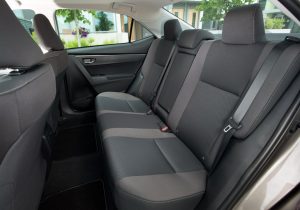
This is also unique.
Other “compacts” in the Corolla’s price range have tighter back seats – most of them much tighter back seats.
You’ll also get more than an “entry-level” compact sedan – i.e., a stripped-down cheapster.
No such car exists anymore – and not just at Toyota stores. Not if “entry level” is synonymous with “basic” or even “minimally equipped.” Try and find any new car that doesn’t come standard with most power options, air conditioning and a pretty good stereo – at the very least.
In addition to those expected things – those now-given things – the Corolla adds adaptive cruise control, a 6.1 inch LCD touchscreen with Siri Eyes Free voice control, tilt and telescoping steering wheel, a six-speaker stereo, LED headlights with automatic high beam control, automated emergency braking, steering assist and pedestrian detection.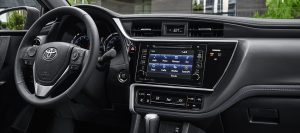
All standard.
And all for a lot less than the cost of a Camry.
Toyota doesn’t put that in Corolla’s press kit. But it might be something you’d like to know about.
WHAT IT IS
The Corolla is – nominally – a small sedan in the same class as the Honda Civic, Kia Rio/Hyundai Accent twins, the Ford Fiesta – and so on.
Except it’s not small in the backseat – as most of the rest of them are. As all of them are when compared with Corolla.
It’s also available with a manual transmission. Good luck finding one of those in a mid-sized car.
Any midsize car.
Base price is $18,550 for the base L trim – with six-speed manual. There are also LE, fuel-sippy LE Eco, luxury-trimmed XLE and sporty SE trims.
A top-of-the-line XSE with continuously variable (CVT) automatic, heated seats, leather trimmed interior, a larger 7 inch touchscreen, navigation and HD/satellite radio stickers for $22,730.
There is also a five-door hatchback version of the Corolla – the Corolla iM.
This variant used to be sold exclusively under Toyota’s youth-focused Scion label, but Scion folded its tent after the 2016 model year and the iM is now officially a Toyota.
Base price for that one is $18,850 for the manual-equipped version and $19,590 with the CVT automatic.
WHAT’S NEW
The Corolla was updated last year; the 2018 carries over with just a few minor changes to trim and options.
Mid-sized car’s back seat space.
Exceptional fuel economy (40 on the highway for the LE Eco trim).
No turbocharger – so no worries about down-the-road turbocharger replacement.
No direct injection. No worries about carbon-fouled valves.
WHAT’S NOT SO GOOD
Costs significantly more than several models it competes with. If you don’t need a mid-sized car’s back seat space, you can save thousand of dollars by going with a rival such as the Kia Rio/Hyundai Accent – which is similarly nice and similarly equipped but stickers for $14,200 to start. A Nissan Versa sedan costs even less – $12,110 to start.
Civic is the one you want, if you want more engine. Equipped with its optional 1.5 liter turbocharged engine, the Honda gets to 60 several seconds sooner.
As is the case with almost all new cars that still offer a manual transmission, Corolla only offers it with the base L trim. This means if you’d like the features/equipment offered only in the higher trims, you have to accept the automatic transmission that’s part of the deal.
Corolla comes with a 1.8 liter engine in two states of tune, depending on the trim you go with.
All trims except the LE Eco get a 132 hp version, which you can pair with either a six-speed manual transmission (L trim) or the otherwise standard (in the higher trims) continuously variable (CVT) automatic transmission.
The LE Eco gets a modified version of the 1.8 liter engine that makes 140 hp. This version comes paired only with the CVT automatic.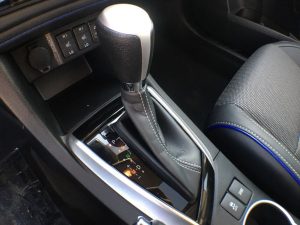
Weirdly – at least in terms of marketing – the stronger engine is also the “economy” engine.
Usually, the most economical engine in the lineup is also the least powerful engine in the lineup.
The 140 hp LE Eco with the CVT automatic gets the highest mileage: 30 city, 40 highway vs. 27 city, 35 highway for the “sporty” – and less powerful – SE Corolla with the six-speed manual.
The LE Eco also features low rolling resistance tires on 15-inch rims (you can upgrade to 16s if you don’t mind losing an MPG or two) aerodynamic tweaks (an underbody air diffuser) and an AC system tuned for least drag on the engine.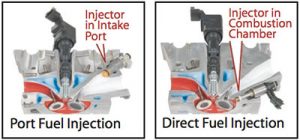
Both versions of the 1.8 liter engine are port fuel injected – not direct injected.
This is a good thing, if you know a thing or two about the difference between these two ways of feeding fuel to an engine. PFI sprays the fuel from above, which cools and cleans the engine’s intake valves as you drive. Gas is a solvent; it dissolves crud – carbon – that would otherwise tend to accumulate on the backsides of the valves, which would eventually have to be cleaned off some other way. That other way often involves partial disassembly of the engine, which as you can probably imagine, isn’t a cheap way.
With DI engines, that way is often the only way.
In a DI engine, fuel is sprayed directly into the cylinder and does not wash over the valves. They are not cooled – or cleaned. Crud – carbon – tends to accumulate. Eventually, the valve can’t fully close – seal – because of all that crud. Which must then be cleaned off the expensive way.
So why is DI replacing PFI? What is the advantage?
There is a slight fuel efficiency (and power gain). About 5 percent is typical vs. the same engine fed via PFI. But this gain should be weighed against the potential cost of down-the-road repairs as well as the higher up-front cost of the DI system itself, which includes two fuel pumps and other DI-specific gear.
The Corolla still has PFI because it’s not the newest kid on the block. The current model was “all new” back in 2014. Since then, the pressure – from Uncle – to squeeze out an additional MPG here and another MPG there has increased significantly. This is the real reason why most cars designed within the past two or so year – and all cars coming down the pike – have DI rather than PFI.
Not because buyers are clamoring for it.
The Corolla is no Corvette. Or Civic, for that matter.
Mash the accelerator and the Corolla will eventually accelerate. Best-case scenario is 0-60 in the mid-high nines. This isn’t palsied. It’s just not . . . quick.
If you need speed, the Civic is more up your alley. Equipped with its optional 1.5 liter engine, the Honda accelerates to 60 in about 7 seconds flat – almost three seconds speedier than the Toyota.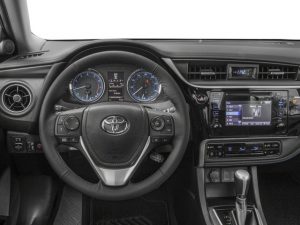
But the Corolla doesn’t care. Or rather, the people who buy Corollas – and there are lots of those people – don’t care. Because speed is not what the Corolla is about.
Comfort is.
And, quiet.
On those counts, the Corolla pulls away from the rest like a Corvette does from a Chevette.
Toyota went to a lot of trouble to tune out the outside world. The Corolla has an acoustic laminated windshield, an inner dashboard silencer pad, extra sealing in the cowl area near the base of the windshield and inner fender insulators. Close the door and it’s tight – like the deep-sea submersible James Cameron used to descend to Titanic’s watery grave.
The absence of road/wind noise is exceptional – and has a calming effect on the driver. This car is a refuge in traffic, a fortress of solitude in the stop-and-go hell of the morning (and evening) commute.
Acceleration isn’t exceptional – but the lack of engine/drivetrain noise is. Even the CVT-equipped versions. Often, CVT-equipped cars with not-so-powerful engines produce a lot of caterwauling as they try to accelerate. Not the case here. It may take a second or three longer to get to 60 than in the Civic, but so what?
That’s what makes the Corolla stand out – even if car journalists often don’t see it. They fixate on a car’s 0-60 time. How quick the steering feels. How deftly it corners at the limits of grip.
The millions of happy Corolla buyers think about the everyday drive.
At which Corolla excels – and has few peers among cars of its kind.
It drives like a posh mid-sized car. Which for all practical purposes, it is.
The Corolla sedan is 183.1 inches long overall – which is just slightly longer overall than the just-redesigned Honda Civic sedan (182.3 inches). Both of these cars are edging ever-closer to being mid-sized cars on the outside. For a sense of scale, the Ford Fiesta sedan – nominally in the same class – is only 173.5 inches long overall; the Yaris iA is 171.7 inches long overall.
But the Corolla’s much roomier inside than the almost-mid-sized on the outside Civic.
Both cars have the same 42.3 inches of legroom up front, but the Corolla’s stupendous 41.4 inches of backseat legroom is untouchable by the Civic (37.4 inches) or any other car in this class.
The Fiesta’s back seats – 31.2 inches of legroom – are punishing in comparison. Even the Nissan Versa – which has 37 inches of backseat legroom, more than all the others in this class except the Civic – seems cramped in comparison with the Corolla’s.
You would literally have to move up to a full-size car – like Toyota’s Avalon sedan, which is larger than the Camry sedan – to find comparable backseat legroom. And even then, the Avalon still hasn’t got quite as much backseat legroom as the Corolla does.
The Space Factor sets the Corolla apart – puts it in a class by itself. There isn’t another car available at this price that’s not only viable as a family car but desirable as a family car.
And not just because it’s spacious.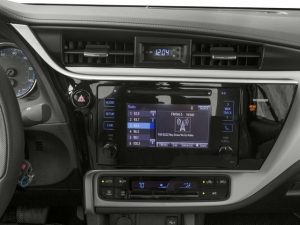
Like its “entry level” rivals, the Corolla has more standard amenities than luxury cars used to offer – including a 6.1-inch touchscreen. But the Corolla steps it up with adaptive cruise control and automatic high beam LED headlights, standard Siri voice control and an entire suit of addled-driver intervention systems that includes automated emergency braking, lane departure warning with steering assist and pedestrian detection.
It’s debatable whether these are necessary if you’re not an addled driver in need of such interventions. But what’s not debatable is that finding them included as standard equipment in an $18k car is startling. Few cars in this class even offer all this stuff – and just a couple of years ago, the only way to get this stuff at all was to buy a $50k (and up) car.
The hatchback Corolla has more cargo room – 20.8 cubic feet, about twice the sedan’s 13 cubic feet – and the space is more usable because of the hatchback’s liftgate vs. the sedan’s trunk lid- but be advised that backseat legroom in this version is much less than in the sedan. Just 32.7 inches – about the same as in the bring-out-the-gimp Fiesta.
There’s also a bit less legroom (42.7 inches) for the driver and front-seat passenger, too.
It’s a shame that Toyota doesn’t let you have the stronger version of the1.8 liter engine in the sport-themed SE trim – and bizarre that this trim is automatic-only. Granted, most Corolla buyers aren’t hot shoes, but those who are interested in a sporty Corolla might like one with a manual transmission.
On the other hand, there is great sagacity in such things as the Corolla’s steel wheels and sane-sized tires. No Gnomesayin’ stupid-sized “rims” that add to the unsprung mass and rolling resistance of the car. No short sidewall tires that ride rough and are much more easily hurt by potholes.
Drum brakes out back, too – for all but the LE Eco trim. Why is that good? Because drums are hard to hurt. If a greasepit gorilla with an air gun over-torques the lug nuts, there are no rotors (out back) to warp.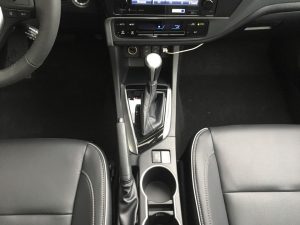
And there is a manual, pull-up emergency brake. No electric pushbutton “e” brake which makes a simple thing complicated and adds yet another potentially expensive thing to fix when it breaks to the car’s total ownership costs. Besides which, the manual emergency brake can be used to do 180s ad 360s and other such fun things which can’t be done with a got-damned “e” brake.
There’s no aggravating auto-stop “feature,” either.
The engine stays running until you decide to turn it off. The Corolla lacks this crap because it’s not new enough to be hag-ridden by the latest technological idiocies foisted on us because of increasingly demented government fatwas, such as those demanding cars average at least 34.5 miles-per-gallon.
Auto-stop might save you half an MPG – maybe even a whole MPG. But payback will bite you in the ass in the form of shortened battery life (think of all those start cycles) and – probably – shorter starter life.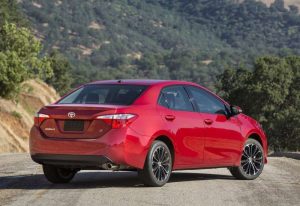
Corolla is still a pretty simple car, for a modern car.
Naturally, that won’t last
THE BOTTOM LINE
She’s not sexy at first glance, but the more time you spend with her, the more you’ll like having her around.
. . .
Got a question about cars – or anything else? Click on the “ask Eric” link and send ’em in!
If you like what you’ve found here, please consider supporting EPautos.
We depend on you to keep the wheels turning!
Our donate button is here.
If you prefer not to use PayPal, our mailing address is:
EPautos
721 Hummingbird Lane SE
Copper Hill, VA 24079
PS: EPautos magnets – they’re back! are free to those who send in $20 or more to support the site. Also, the eBook – free! – is available. Click here. Just enter you email in the box on the top of the main page and we’ll email you a copy instantly!


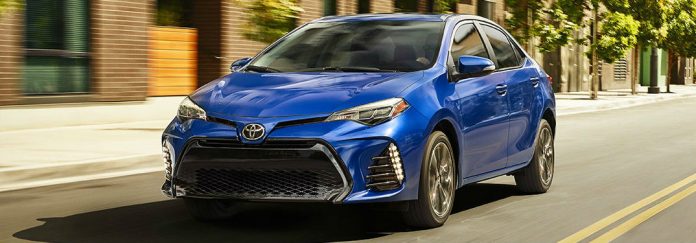

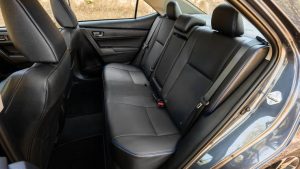
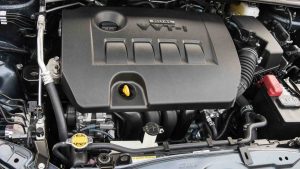


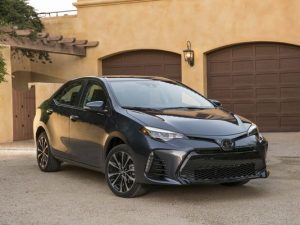
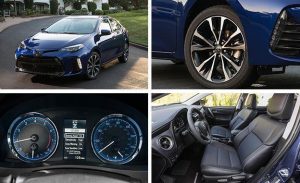








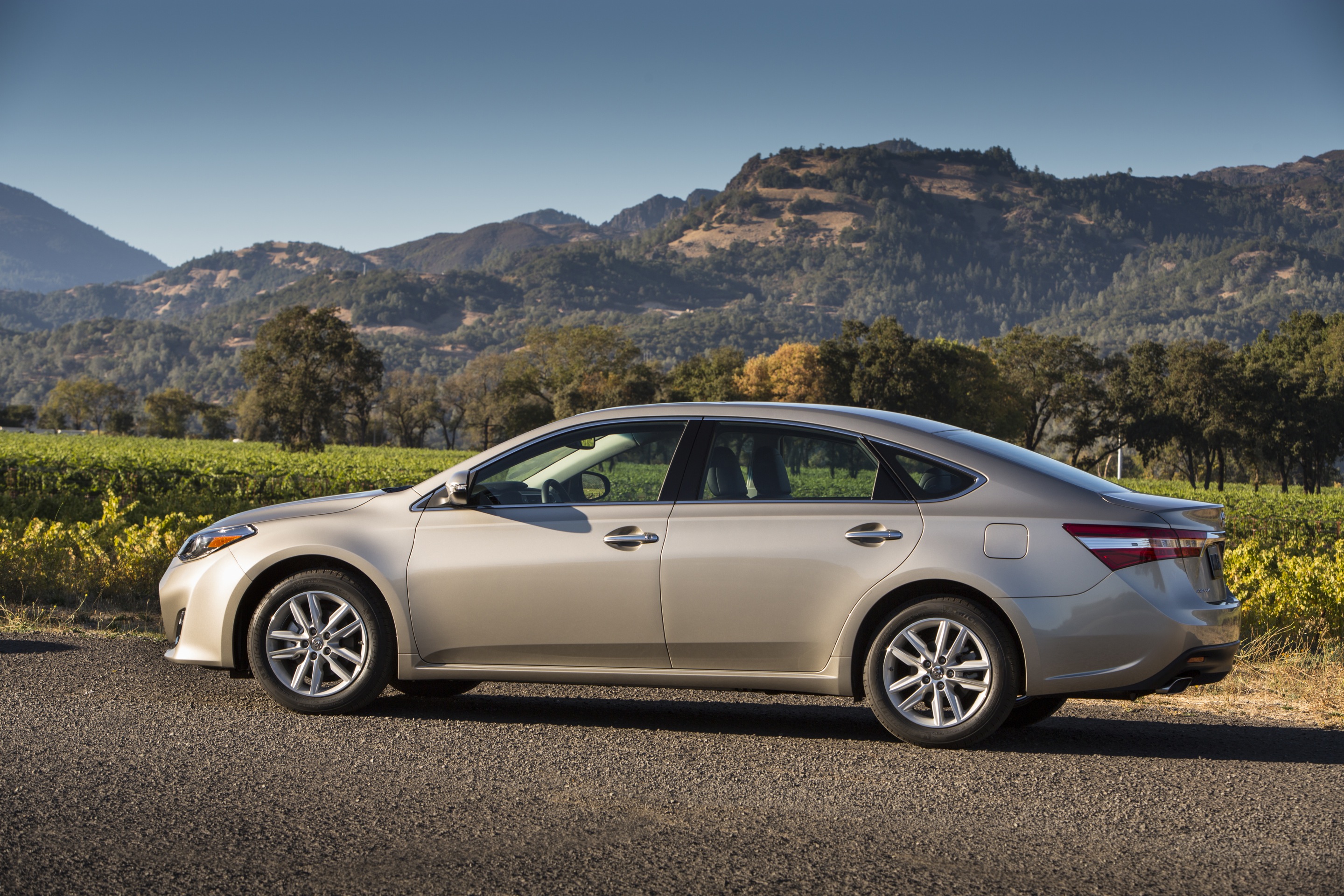
Our 2010 corolla easily gets 40 mpg on the highway. Not much progress here. Although the improved acoustics do sound nice. Great write-up as always.
Thanks, Tyler!
The Corolla is a favorite of mine because of its easygoing nature, low price and very generous room. It’s not exciting, but that’s not the point!
I believe the Corolla’s direct competitors are the Ford Focus, Hyundai Elantra and Kia Forte, and not the mentioned Fiesta, Accent and Rio. Let’s compare apples to apples 😉
I test drove one of these and “eventually” is the correct word…
Tried booting the pedal to see what the over-taking ability was like… and I thought I must have broken it or something, as it simply didn’t respond, at all, for about 2 whole seconds, while some computer somewhere decided to think about.
It did ‘eventually’ begin to accelerate, but that was the end of the test drive. Turned around at the next junction and took it back to the dealership.
No thanks.
It’s amazing how far the Corolla has come. I remember them from the 80s when they really were tin cans, with thin doors and thinner carpet. They also had a four-speed automatic for years, because their owners didn’t care about winning stoplight races.
Of course, a Corolla isn’t cheap any more. It’s apparently easy to option one-up to $30k.
Chip H.
“Weirdly – at least in terms of marketing – the stronger engine is also the “economy” engine.
Usually, the most economical engine in the lineup is also the least powerful engine in the lineup.”
Same holds true for the TACOMA as well . . . .
So, “LED headlights with automatic high beam control” on the base L model?
Acoustic winshield on the base model as well?
Usually at this price point one has to step up one trim-line for the acoustic wndshield and up to the top trim for LED headlights.
“But when it comes to passenger space, the Corolla has almost the same interior space; more space when it comes to backseat space: 41.4 inches vs. 38 for the “mid-sized” Camry.”
It’s even weirder than that. The 2018 Corolla has essentially the same legroom up front as the 2018 Avalon, and about 2 inches MORE legroom in the back (Corolla 42.3/41.4, Avalon 42.1/39.2). Hell, the Corolla has significantly MORE legroom front AND rear than the flagship 2018 Lexus LS (41.0 / 38.9 in), and slightly MORE headroom.
About the only area where the Lexus LS is bigger than the Corolla is leg room, hip room, and trunk space.
Basically, they carved out a full sized interior for the Corolla, then narrowed it a bit and shrank the trunk somewhat.
They’ve always been incredibly functional, simple, and durable.
But this new one is incredibly ugly on the front end, loaded up with every CAD derived styling cliche.
Yeah, not a fan of the Darth Vader front end.
I wonder if the old trick of a fine water mist down the air intake (or carburetor back in the day) would knock off some of that carbon crud?
Probably not hot enough, but…
Eric,
Great write up. 🙂
I think at $81,850, I would choose a Porche Boxster over the Toyota. 😉
There was one thing pointed out as a “feature” on the car: “The Corolla has an acoustic laminated windshield…”
As a Canadian who regularly has to replace a front windshield every 2 or 3 years, primarily due to the winter gravel so generously poured on our roads, that is a “liability”, not a “feature.”